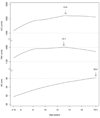Associations between IQ, total and regional brain volumes, and demography in a large normative sample of healthy children and adolescents
- PMID: 20446134
- PMCID: PMC2869200
- DOI: 10.1080/87565641003696833
Associations between IQ, total and regional brain volumes, and demography in a large normative sample of healthy children and adolescents
Abstract
In the course of efforts to establish quantitative norms for healthy brain development by magnetic resonance imaging (MRI) (Brain Development Cooperative Group, 2006), previously unreported associations of parental education and temporal and frontal lobe volumes with full scale IQ and its verbal and performance subscales were discovered. Our findings were derived from the largest, most representative MRI sample to date of healthy children and adolescents, ages 4 years 10 months to 18 years 4 months. We first find that parental education has a strong association with IQ in children that is not mediated by total or regional brain volumes. Second, we find that our observed correlations between temporal gray matter, temporal white matter and frontal white matter volumes with full scale IQ, between 0.14 to 0.27 in children and adolescents, are due in large part to their correlations with performance IQ and not verbal IQ. The volumes of other lobar gray and white matter, subcortical gray matter (thalamus, caudate nucleus, putamen, and globus pallidus), cerebellum, and brainstem do not contribute significantly to IQ variation. Third, we find that head circumference is an insufficient index of cerebral volume in typically developing older children and adolescents. The relations between total and regional brain volumes and IQ can best be discerned when additional variables known to be associated with IQ, especially parental education and other demographic measures, are considered concurrently.
Figures
References
-
- Akaike H. A new look at the statistical model identification. IEEE Transactions on Automatic Control. 1974;19(6):716–723.
-
- Andreasen NC, Flaum M, Swayze V, 2nd, O7Leary DS, Alliger R, Cohen G, et al. Intelligence and brain structure in normal individuals. American Journal of Psychiatry. 1993;150(1):130–134. - PubMed
-
- Aylward EHMN, Field K, Sparks BF, Singh N. Effects of age on brain volume and head circumference in autism. Neurology. 2002;59(2):175–183. - PubMed
-
- Bartholomeusz HH, Courchesne E, Karns CM. Relationship between head circumference and brain volume in healthy normal toddlers, children, and adults. Neuropediatrics. 2002;33(5):239–241. - PubMed
-
- Brain Development Cooperative Group. The NIH MRI study of normal brain development. NeuroImage. 2006;30:184–202. - PubMed
Publication types
MeSH terms
Grants and funding
- N01-HD02-3343/HD/NICHD NIH HHS/United States
- N01-NS-9-2329/NS/NINDS NIH HHS/United States
- P50 MH060450/MH/NIMH NIH HHS/United States
- N01-NS-9-2319/NS/NINDS NIH HHS/United States
- R01 MH080826/MH/NIMH NIH HHS/United States
- N01 HD023343/HD/NICHD NIH HHS/United States
- R01 NS034783/NS/NINDS NIH HHS/United States
- N01-NS-9-2317/NS/NINDS NIH HHS/United States
- N01-NS-9-2316/NS/NINDS NIH HHS/United States
- N01-MH9-0002/MH/NIMH NIH HHS/United States
- N01-NS-9-2314/NS/NINDS NIH HHS/United States
- P50 MH60450/MH/NIMH NIH HHS/United States
- N01-NS-9-2315/NS/NINDS NIH HHS/United States
- R01 HD048946/HD/NICHD NIH HHS/United States
- R01 NS34783/NS/NINDS NIH HHS/United States
LinkOut - more resources
Full Text Sources
Other Literature Sources


